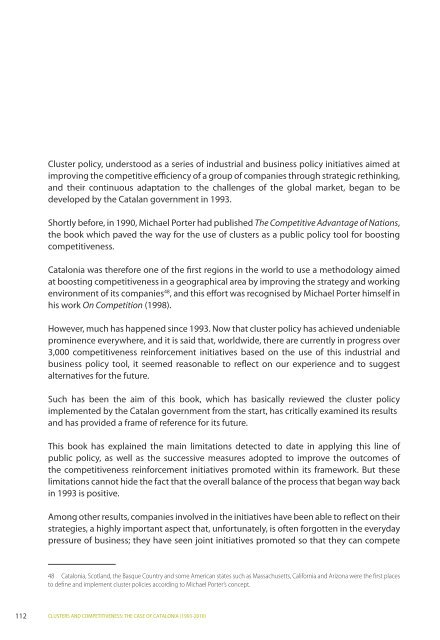Clusters and competitiveness - PRO INNO Europe
Clusters and competitiveness - PRO INNO Europe
Clusters and competitiveness - PRO INNO Europe
You also want an ePaper? Increase the reach of your titles
YUMPU automatically turns print PDFs into web optimized ePapers that Google loves.
Cluster policy, understood as a series of industrial <strong>and</strong> business policy initiatives aimed at<br />
improving the competitive efficiency of a group of companies through strategic rethinking,<br />
<strong>and</strong> their continuous adaptation to the challenges of the global market, began to be<br />
developed by the Catalan government in 1993.<br />
Shortly before, in 1990, Michael Porter had published The Competitive Advantage of Nations,<br />
the book which paved the way for the use of clusters as a public policy tool for boosting<br />
<strong>competitiveness</strong>.<br />
Catalonia was therefore one of the first regions in the world to use a methodology aimed<br />
at boosting <strong>competitiveness</strong> in a geographical area by improving the strategy <strong>and</strong> working<br />
environment of its companies 48 , <strong>and</strong> this effort was recognised by Michael Porter himself in<br />
his work On Competition (1998).<br />
However, much has happened since 1993. Now that cluster policy has achieved undeniable<br />
prominence everywhere, <strong>and</strong> it is said that, worldwide, there are currently in progress over<br />
3,000 <strong>competitiveness</strong> reinforcement initiatives based on the use of this industrial <strong>and</strong><br />
business policy tool, it seemed reasonable to reflect on our experience <strong>and</strong> to suggest<br />
alternatives for the future.<br />
Such has been the aim of this book, which has basically reviewed the cluster policy<br />
implemented by the Catalan government from the start, has critically examined its results<br />
<strong>and</strong> has provided a frame of reference for its future.<br />
This book has explained the main limitations detected to date in applying this line of<br />
public policy, as well as the successive measures adopted to improve the outcomes of<br />
the <strong>competitiveness</strong> reinforcement initiatives promoted within its framework. But these<br />
limitations cannot hide the fact that the overall balance of the process that began way back<br />
in 1993 is positive.<br />
Among other results, companies involved in the initiatives have been able to reflect on their<br />
strategies, a highly important aspect that, unfortunately, is often forgotten in the everyday<br />
pressure of business; they have seen joint initiatives promoted so that they can compete<br />
48 Catalonia, Scotl<strong>and</strong>, the Basque Country <strong>and</strong> some American states such as Massachusetts, California <strong>and</strong> Arizona were the first places<br />
to define <strong>and</strong> implement cluster policies according to Michael Porter’s concept.<br />
112 CLUSTERS AND COMPETITIVENESS: THE CASE OF CATALONIA (1993-2010)
















